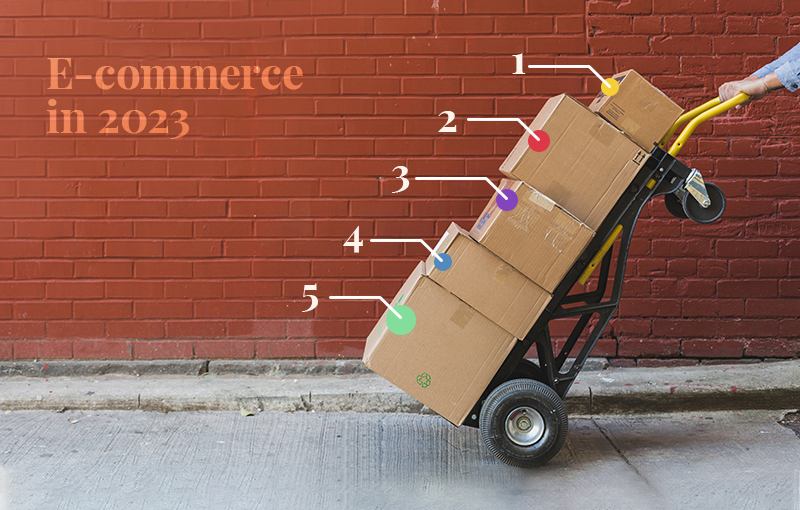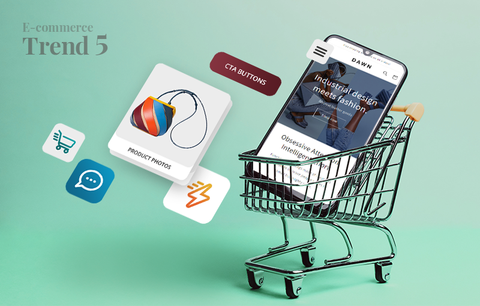

This is the introductory guide to a series of posts dedicated to emerging e-commerce trends. In the following weeks, we’ll publish 5 blog posts that will show you how to future-proof your business and build a brand that lasts.
Today, we’ll have a look at the current e-commerce landscape, discuss the most important shifts in online shopping, and talk about what you should consider going forward.
This guide will also serve as a content hub - a pillar page that unites all posts from the series. So, make sure to bookmark it, as we’ll constantly update it with new information and valuable resources. Let’s commence!
Overview
- The e-commerce landscape
- What to consider going forward?
- 5 e-commerce trends for 2023, and beyond
- Trend 1: The rise of omnichannel retail and multi-channel experiences
- Trend 2: Long-term customer relationships take center stage
- Trend 3: Brand identity becomes paramount
- Trend 4: The rise of social commerce
- Trend 5: The rise of mobile commerce
- Conclusion
The e-commerce landscape
The pandemic had a significant effect on e-commerce. It brought unexpected challenges and entirely changed the way consumers shop online. For example:
- Shipping and acquisition costs are rising at an alarming rate.
- Organic reach is declining. In the meantime, advertising costs are increasing, while returns on advertising spend (ROAS) are plummeting.
- Customers have more demands and higher expectations - they crave an authentic, immersive, and innovative end-to-end shopping experience that remains consistent and seamless across all online surfaces (e.g., your store, social media, ads, etc.) and devices.
- Customers are more selective about which brands they trust and want to support - people are more willing than ever to shop from brands that resonate with them and align with their values.
- The pandemic has inspired a sense of togetherness. As a result, support for local and small businesses is at a record-high level. In fact, according to Shopify research, 46% of buyers in the US and Canada had made purchases from local, independently owned businesses since the pandemic started. Of that group, 34% reported doing this more often than they did pre-pandemic, and 57% said they specifically sought out local, independently-owned businesses to support.
- Customers have less tolerance for slow delivery times (unless it is for the right brand). In the meantime, merchants have to deal with ongoing supply chain issues.
- There has been a significant increase in the number of channels merchants are selling on - online stores, showrooms, pop-up shops, physical stores, social media channels and storefronts, etc.
As a result, merchants became more resilient and adaptive. This is great because 2023 will bring new challenges and even more exciting opportunities. Despite the obvious increase in online shopping, consumers are returning to in-person shopping. But they are also looking to shop in new ways - social commerce sales are set to nearly triple by 2025, and 40% of consumers plan to pay with cryptocurrency in the next year (source: Shopify, 5 Pandemic Buying Habits That Are Here to Stay—According to Shopify Research).
This means that merchants will need to create an end-to-end seamless shopping experience optimized toward current buying habits and consumer expectations. We’ll show you how to achieve this in a series of articles dedicated to emerging e-commerce trends - we’ll share best practices, inspiring examples, and, most importantly, Shopify-specific insight. So, stay tuned!
What to consider going forward?
The key to success in 2023 and beyond is to set yourself apart from your competitors - showcase what makes your brand special, and give specific reasons why consumers should trust you.
Keep in mind that people want to shop from brands that stand for something - brands with mission and values that align with their personal views. This means that you should focus on building and showcasing your brand identity and emphasize customer retention and lifetime value.
How? You must invest in unique offerings, a stellar customer experience (from product discovery to post-purchase interactions), impeccable and personalized support, and building a vibrant community that brings value and keeps customers coming back.
Achieving all this is not easy. But with the right guidance, you’ll be able to set yourself up for success. Hopefully, following the trends and advice we’ll share in this blog series will get you on the right track.
5 e-commerce trends for 2023, and beyond
We’ll have a look at 5 trends that will shape the future of e-commerce:
- The rise of omnichannel retail and multi-channel experiences
- Long-term customer relationships take center stage
- Brand identity becomes paramount
- The rise of social commerce
- The rise of mobile commerce
Trend 1: The rise of omnichannel retail and multi-channel experiences
As Harley Finkelstein, Shopify President, puts it, “Digital and physical retail don’t operate as silos: it’s all just retail. The opportunity in retail lies in creating a seamless experience between online and offline.”
In this article, we’ll show you how to create seamless end-to-end customer experiences, delivered across different channels and touchpoints - from your Shopify website to your physical store or pop-up shop.
Also, we’ll show you how to leverage cutting-edge technology like AR/VR and 3D modeling, and how to use Shopify POS to jump on the omnichannel commerce trend.
Trend 2: Long-term customer relationships take center stage
In recent years, people have become more experienced online shoppers. As a result, they have higher expectations. The omnichannel shopping experience is just one piece of the puzzle. Customers also expect a personalized shopping experience, on-demand customer support, and lightning-fast order fulfillment. In addition, they have become more selective about the brands they shop from. Ultimately, if you want to succeed, you must focus on building long-term customer relationships.
In this article, we’ll show you how to nurture such relationships. We’ll talk about transparency in brand communication and messaging. Also, we’ll show you how to deliver a stellar end-to-end shopping experience that promotes brand loyalty and business growth. More specifically, you’ll learn:
- How to leverage Shopify’s multi-language feature with the help of native translation apps like Translation Lab.
- How to use Shopify Sales channels to deliver a consistent, seamless, and highly personalized shopping experience across different channels and online surfaces.
- How to use content, customer support, and Shopify Shop to design a stellar post-purchase experience and keep your customers coming back to your store.
Trend 3: Brand identity becomes paramount
In 2023, brand identity will be paramount. Topics like social responsibility and sustainability, personalization, and authenticity will take center stage.
In this article, we’ll show you how to showcase and communicate your sustainability efforts and share several outstanding examples. We’ll talk about personalization beyond email marketing and ad targeting. We’ll discuss authenticity and how you can differentiate your brand.
Trend 4: The rise of social commerce
Before the pandemic, social storefronts were nice-to-have - an opportunity that only innovative businesses would consider. This is no longer the case. Today “social is the interface of commerce and the backbone of the new customer experience” (source: Étienne Mérineau).
In 2023, people are expected to use social media in every stage of their buyer journey (across different product categories). Therefore, having a social storefront is no longer just nice-to-have but an absolute must.
In this article, we’ll show you how to capitalize on this lucrative trend. More specifically, you’ll learn:
- How to leverage Instagram and effectively promote your business.
- How to use Facebook Commerce.
- How to achieve tremendous success on TikTok.
- How Shopify can make all this a breeze. We will cover campaign management (right from the Shopify admin), syncing your product catalog with your social media business accounts, and the amazing in-app integration with TikTok that allows you to control all-things-TikTok from the Shopify TikTok sales channel.
Trend 5: The rise of mobile commerce
Retail m-commerce sales hit 359.32 billion in 2021, an increase of 15.2% over 2020. By 2025, retail m-commerce sales are expected to reach $728.28 billion and account for 44.2% of retail e-commerce sales in the US (source: Rise of Mcommerce: Mobile Ecommerce Shopping Stats & Trends in 2022).
If you want to keep up with these numbers, having a responsive website is not enough. You must deliver an outstanding mobile shopping experience. In this article, we’ll show you how to achieve this.
We’ll discuss mobile-first design principles and best practices. We’ll show you how to arrange your products in a way that delivers a delightful shopping experience on mobile. Also, you will learn how to optimize your store’s speed on mobile, navigation, CTA buttons, checkout and mobile forms, and much more!
Conclusion
The e-commerce landscape has changed a lot in the past years - the pandemic brought unprecedented challenges, but it also created a ton of amazing opportunities.
In the following weeks, we’ll publish 5 blog posts, packed with value and Shopify-specific insight, dedicated to emerging e-commerce trends.
Right now, the road ahead may seem long and winding. But after reading the blog posts from the series, you’ll feel more prepared, and you’ll be able to set yourself for success in 2023 and the years to come! So, stay tuned!
If you have further questions or comments, just drop us a line in the comments section below!



